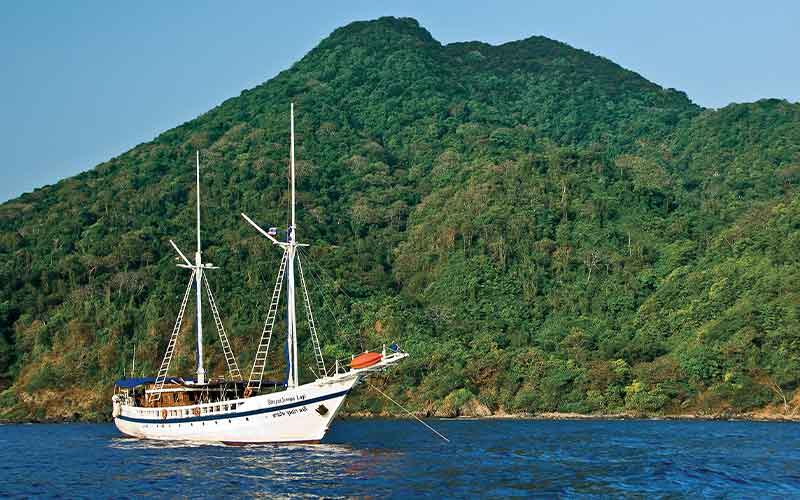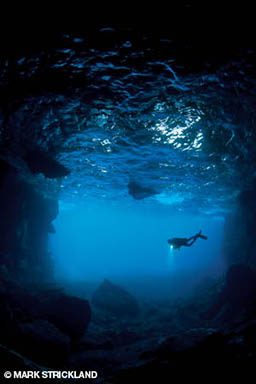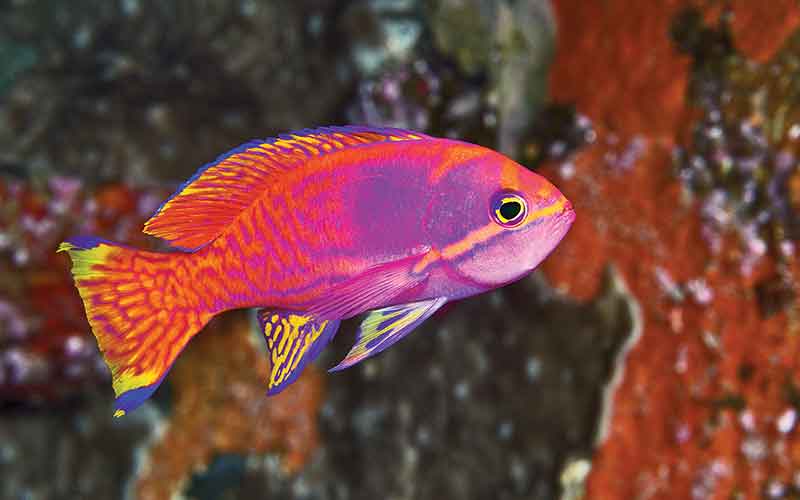Preparing to back-roll off the liveaboard’s inflatable launch at Barren Island, I had a brief moment of anxiety. For nearly two decades I’d dreamed of diving this isolated volcano among India’s Andaman Islands, and at last the dream had become reality. But would the dive live up to my expectations?
When the bubbles cleared, I was astounded by the vast, blue panorama before me. The water pulsed with life as scores of pyramid butterflyfish paraded along the wall, mingling with clouds of surgeonfish and bannerfish. Occasionally their ranks would part, as squadrons of dogtooth tuna pierced the formation. Visibility was superb, and the black volcanic substrate created an intriguing visual effect, making distant coral heads appear somehow suspended in midwater.

Spiraling downward in a joyous freefall, I settled on an outcropping known as Purple Haze, where an assortment of reef fish soon emerged. First to arrive was a vividly hued lunartail grouper, followed by a young Napoleon wrasse that studied me with bulbous green eyes. Suddenly a shadow covered the ledge, as a manta ray the size of a garage door passed overhead. Instinctively I began swimming a parallel course, but the ray easily outpaced me. The effort was richly rewarded, however, as the chase led me to several steep ridges projecting into the current. Vibrant soft corals dominated the scene, their purplish stalks complimented by yellow and crimson sponges and accented by dense swarms of orange anthias.
The dive had only begun, but it was clear that I had worried for nothing. This was simply the most picturesque and pristine reef I’d ever seen.
Paradise Found

Known as the Emerald Isles because of their verdant terrestrial forests, India’s Andaman Islands are isolated, barely explored and largely untouched, offering a rare glimpse of tropical islands and reefs in their natural state. The archipelago stretches roughly 225 miles from north to south and consists of about 200 islands, only 26 of which are inhabited. Geographically closer to Thailand and Myanmar than to India, the islands are little known to the outside world, and aside from the main settlement of Port Blair, pollution is virtually nonexistent. Getting here has never been easy, but that’s part of the appeal. Except for low-impact ecotourism, the islands remain relatively untouched by modern civilization.
Underwater, the Andamans are a treasure trove of marine life, with vast areas of unexplored reef and a wide range of habitats. Fishing regulations are strictly enforced, so foreign fleets give them a wide berth, and local fishing pressure is light. The result is unusually healthy fish populations, including large species like Napoleon wrasse and Malabar groupers, animals that are rapidly disappearing in other Indo-Pacific destinations. mobula rays, often in large numbers, are a common sight. There are also unusual species including flashlight fish, ghost pipefish and irresistibly cute red-spotted blennies, as well as endemics like the strikingly patterned Andaman sweetlips and electric-blue Andaman damselfish. Another signature fish is the distinctive Indian spinecheek anemonefish, whose vertical bars are bright yellow instead of the typical white or gray. Banded sea snakes are seen on nearly every dive, and while the Andamans will never be known as a “critter” hotspot, there is a reasonably good assortment of invertebrates, including wire coral shrimp, colorful trapeze crabs, nudibranchs and bobtail squid.
Excellent diving can be found throughout the island chain, but the most spectacular sites are located at Narcondam and Barren islands. Both are designated wildlife sanctuaries, but their remote locations mean the best way to get there is by liveaboard.
Narcondam Island: Ooh La La
The view of Narcondam as you approach is unforgettable as the island’s conical peak rises in stark contrast to the open sea surrounding it. It’s obviously volcanic in origin, but with no eruptions for thousands of years, Narcondam’s steep slopes are covered in dense forest. While there are no large mammals, the island is home to a healthy wildlife population, including endemic species like the Narcondam hornbill and the Andaman horseshoe bat. The only human inhabitants are a handful of park rangers, who maintain a tidy compound and keep a close eye on the natural resources.

Narcondam’s prime dive sites include rocky ridges and steep slopes like Chimneys, Ooh La La and Lighthouse Reef, where massive barrel sponges, huge gorgonian fans and lush soft corals thrive in often-vigorous currents. Fish life can include heavyweights like Napoleon wrasse, bumphead parrotfish and mantas, as well as occasional whitetip and gray reef sharks. Another special place is HQ Pinnacle, where a submerged rock formation acts as a magnet for hefty dogtooth tuna and hundreds of bigeye trevally. For a more tranquil setting, several bays around the island offer gently sloping terrain populated with fields of hard corals and plenty of colorful reef fish. Well protected from the current, these bays are ideal for an easy afternoon dive.
Barren Island: That Old Black Magic
Also surrounded by miles of deep, open sea, Barren Island has a rather misleading name, since it’s also heavily forested. Unlike Narcondam, however, there is ongoing volcanic activity here. Immediately below the smoking, sulfur-encrusted summit, a dark swath of lava rock reaches all the way to the water’s edge, where it flowed during the most recent eruption in 2005. Some of the most colorful dive sites are located on the island’s east side, including Purple Haze. Another standout, Black Magic, consists of a shallow ridge of jet-black sand, where fields of garden eels surround clusters of sand divers. Hovering in midwater, the male sand divers put on an impressive show, flashing neon colors and flaring fins to intimidate their rivals. Only a few kicks down either side of this sand slope is the main attraction — a thriving reef that drops precipitously into bottomless depths. The contrast between inky sand and vibrant reef life could not be more striking, as if the purple soft corals and red encrusting sponges were being viewed under a black light.
Complementing the scene is an ever-changing assortment of reef fish and pelagics, occasionally including mantas and even whale sharks. Farther west, a triangular, hard coral plateau is bordered by vertical drops on two sides, each heavily encrusted with sponges and gorgonians. Like most of Barren Island, it is a perfect multilevel site, with compelling scenery and thriving fish life at every depth, right up to 15 feet. There are also sloping reefs such as South Bay, where an extensive coral garden is dotted with large boulder corals and yellow sponge, and populated by fish ranging from tiny gobies to mantas.

Passage Island: Fish Rock
Toward the south end of the main island chain, another highlight is Passage Island, where the sloping reef is alive with schooling species like redtooth triggerfish, humpback snapper and Oriental sweetlips, along with bigger fish like giant sweetlips and Napoleon wrasse. On several occasions we encountered schools of at least 50 mobula rays, rotating like a carousel just off the reef. Spellbound, we sat motionless as they circled, then formed a single stream and soared into deeper water. One, however, lagged behind, assumed a vertical position over a table coral and slowly flapped its wings while being cleaned. Another time, I watched a school of juvenile golden trevally swimming in tight formation over the sand, perhaps 40 feet below. Something about the scene looked odd, as a sizable swatch of “sand bottom” seemed to be following the school’s every move. Finally it dawned on me — the “sand patch” was actually a giant grouper, probably 6 feet or more in length.

Even more exciting than Passage Island is a small pinnacle that barely breaks the surface off the island’s northwest side. Known as Fish Rock, this place easily lives up to its name, as nearly every dive begins with a swirling school of surgeonfish and chevron barracuda in midwater, sometimes accompanied by rainbow runners and dogtooth tuna. Once, a pair of huge potato cod joined the welcoming committee, eyeing us intently as we descended on their turf. While much of the seascape is rather colorless, portions of the deep slope are covered with small, pink soft corals, barrel sponges, green Tubastrea coral trees and huge orange fans. Schooling fish are especially abundant here, as massive waves of bluestripe snappers, yellowback fusiliers and bannerfish ebb and flow across the reef. In shallower areas, bumphead parrotfish graze on branching corals, creating an audible crunch each time they close their powerful jaws. This is not a site for inexperienced divers, however, as strong currents often require a quick descent until reaching the reef base, where the flow tends to ease considerably.
Other notable sites amid the main island chain include offshore banks like Minerva Ledge and Campbell Shoal, fringing reefs like South Button, and isolated outcroppings like Dixon’s Pinnacle and Johnny’s Gorge. Since diving is only in its infancy here, there are bound to be countless other sites waiting to be discovered.
Special thanks to Worldwide Dive and Sail, and Jeroen Deknatel, formerly of Ocean Rover Cruises, for their help in preparing this article.
Dive In
Weather and Seasons: The best time to dive the Andamans is during the dry monsoon season, from December through April. Air temperature ranges from 71°F to 92°F. Water temperatures are similar, running between 80°F to 84°F, with occasional thermoclines.
Getting There: Getting to the Andamans requires connecting via Kolkata (formerly Calcutta) or Chennai (formerly Madras), where there are daily flights to Port Blair. Photographers will find the baggage restrictions on the final leg tough to deal with. Most carriers allow only 25 kilograms (55 pounds) total for checked bags, so budget for some overweight charges. Local airlines can also be strict about the 5 kilogram (11 pounds) carry-on limit for one item. There are no allowances for an additional “small personal item.”

Entry Requirements: A tourist visa and passport are required. Passports must be valid for at least six months from arrival date. The Andamans also require a special Restricted Area Permit, which are now issued on arrival at Port Blair airport. If you plan to arrive by sea, arrange for your permit when you apply for your Indian visa. For details, contact or visit the Indian Embassy at +1-202-939-7000;
Dive Operators: Liveaboards are the only practical option for exploring remote islands like Barren and Narcondam. The roster of boats cruising the Andamans is still very limited and varies from season to season. Current choices include S/Y Siren and Mermaid 1. Most trips last eight to 10 days, beginning and ending at Port Blair. Land-based diving is best around Havelock, a lovely, laid-back island that is two to three hours by ferry from Port Blair.

Coral Bleaching in the Andamans
According to reports by the National Oceanic and Atmospheric Administration (NOAA), high water temperatures in early to mid-2010 have caused significant coral bleaching throughout the northern Indian Ocean, including the Andaman Islands. Water temperatures in the region peaked around May 2010 but are now back to normal. As of August, considerable bleaching was still evident on shallow reefs, but corals in deeper areas appeared unaffected. While coral bleaching anywhere in the world is cause for concern, what makes the Andamans special is the combination of soft corals, sponges, gorgonians, abundant fish, big fish and dramatic underwater terrain, none of which were directly affected by bleaching. For more information, visit Coral Reef Watch.
© Alert Diver — Q4 Fall 2010